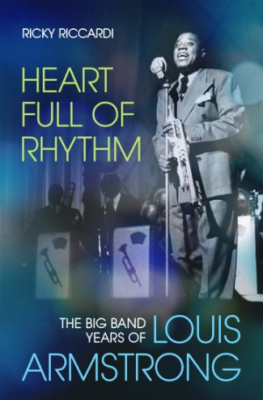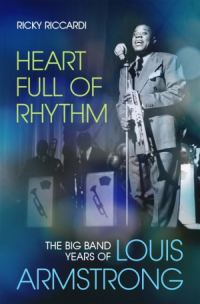.
.
…..In anticipation of an interview with The Louis Armstrong House Museum’s Director of Resarch Collections Ricky Riccardi, I have had the pleasure of spending a few weeks reading his new book, Heart Full of Rhythm: The Big Band Years of Louis Armstrong.
…..Focusing on the years of his big band’s existence (1929 – 1947), this superbly researched, expertly written book is a marvelous read, and filled with the rich history and colorful characters at the center of Armstrong’s career during the era he transformed himself from being a little-known trumpeter in Chicago to an international musical phenomenon, beloved by white audiences while remaining a hero in the Black community.
…..The book spotlights Armstrong’s achievements and career-defining stories, and Riccardi forcefully pushes back against the notion that Armstrong abandoned jazz for the prospects of commercialism, writing that Armstrong “was much more than a jazz musician; he was a popular artist and entertainer who appealed not just to jazz aficionados, but rather to anyone who regularly listened to music and liked to have a good time. If you were hip, you loved Louis Armstrong. If you were square, you loved Louis Armstrong. He ultimately transcended the world of jazz – and for that, the jazz world never truly forgave him.”
…..In the book’s prologue, “Bigger Than Jazz”– a portion of which is published here with the consent of the publisher, Oxford University Press – Riccardi introduces his book by writing about Armstrong’s Apollo Theater performances of 1935 (marking his comeback from an 18 month stay in Europe), his final big band performance of 1947, and subsequent appearances there with his integrated small group, the All Stars.
.
.
___
.
.
“Riccardi’s Heart Full of Rhythm is the best account we have of Armstrong’s vital work with big bands — the research is impeccable, the ardor contagious.”
-Gary Giddins, author of Bing Crosby: Swinging on a Star — The War Years, 1940 – 1946
.
“Dedicated research, access to ideal sources, and fine storytelling combine to shed new light and insight on the most interesting and least well-documented period of Armstrong’s fabled life. Riccardi has done it again, but even more so.”
-Dan Morgenstern, Director Emeritus of the Institute of Jazz Studies, Rutgers University
.
.
photo by Curtis Knapp

Ricky Riccardi is Director of Research Collections for the Louis Armstrong House Museum and author of What a Wonderful World: The Magic of Louis Armstrong’s Later Years. He runs the online blog, “The Wonderful World of Louis Armstrong,” and has given lectures on Armstrong at venues around the world, including the Institute of Jazz Studies, the National Jazz Museum in Harlem, the Bristol International Jazz and Blues Festival and the Monterey Jazz Festival. He has co-produced numerous Armstrong reissues in recent years, including Satchmo at Symphony Hall 65th Anniversary: The Complete Concert, Ella Fitzgerald and Louis Armstrong Cheek to Cheek: The Complete Duets, Pops is Tops: The Verve Studio Albums, and two volumes of Decca Singles for Universal Music, in addition to Columbia and RCA Victor Live Recordings of Louis Armstrong and the All Stars for Mosaic Records.
.
.
From Heart Full of Rhythm: The Big Band Years of Louis Armstrong by
Ricky Riccardi. Copyright © 2020 by Ricky Riccardi and published by Oxford University Press. All rights reserved.
.
.
Prologue
Bigger Than Jazz
.
The Apollo Theater in Harlem is synonymous with some of the greatest names in African American entertainment such as James Brown, Redd Foxx, Ray Charles, Billie Holiday, Michael Jackson—and Louis Armstrong.
…..Louis Armstrong? A man seemingly vilified by the black press and who lost his black fan base over the years because of his out-of-date stage persona? A hero at the Apollo? And in the black press? The way Armstrong’s story is often told, this might be difficult to fathom but it’s all true.
…..Upon his return to the United States in January 1935 after 18 months in Europe, Armstrong’s first stop was the brand-new Apollo. Lip troubles prevented him from playing that evening, but his appearance shook up the theater, causing management to put up a placard stating: “Coming Shortly— Louis Armstrong.”
…..On August 30, 1935, Armstrong finally graced the Apollo stage. There was much apprehension before his appearance. It was his first New York engagement in nearly two years. He hadn’t recorded in America since April 1933. He spent much of the first half of 1935 physically unable to play his trumpet. What kind of shape would he be in? Could he still hit his famed high notes? Should he retire? The black press whipped itself into a frenzy in previewing his return to Harlem. Armstrong himself knew this was a defining moment and took a snapshot of the marquee, keeping it for his personal collection.
…..Harlem turned out in full force for the comeback, which brought in over $10,000 for the week, shattering the theater’s box-office record. Armstrong opened with “Ain’t Misbehavin’,” the song that had made him a star on Broadway, immediately proving that he was back and, in the words of Abel Green in Variety, “better than ever.” Influential columnist Walter Winchell was there and dispensed one of his coveted “New Yorchids” to “Louis Armstrong’s horn-tootling at the Apollo.” Matters were even more ecstatic in the black press. “Any doubt that may have existed in the minds of people that Louis Armstrong’s recent illness has at all impaired his marvelous playing, his distinctive singing, and his magnetic stage personality, is being dispelled by the remarkable performance which he is giving at the Apollo Theatre this week,” gushed the New York Amsterdam News. “It is indeed safe to say that Armstrong is at the peak of his career and that he has given perfect enjoyment to the record audiences which turned out to see and hear him this week.”
…..The love affair with Armstrong at the Apollo was only just beginning and showed no signs of letting up in ensuing years. When he returned in March 1936, Armstrong not only broke his own box-office record but, according to the Pittsburgh Courier, “special police reserves were called out to handle the square-long line of people storming to reach the theatre.” A return in September broke his own record for the second time. Armstrong returned in the middle of a history-making run as host of the Fleischmann’s Yeast radio show in 1937 and broke the box-office record yet again with an appearance at the end of 1938. “Apollo Is Packin ’Em In; Reason!—Louis Armstrong,” read a 1939 Pittsburgh Courier headline over a review by Isadora Smith. “Injecting the jazz-gay abandonment of his race into his version of modern swing and his own popular form of gyration, the great musician actor holds an entertaining spell over the community,” Smith wrote. “In the history of the musical world there have been few men with a more pleasing personality than Armstrong.”
…..Variety agreed when it reviewed Armstrong’s 1940 Apollo run, writing, “The showmanship is still there, however, in large doses, his gravel-throated vocals, etc., helping immensely.” The impact of Armstrong’s showmanship on the Apollo audience was most vividly captured by black writer Peter Suskind in the New Journal and Guide in 1942:
Louis takes a deep breath, shuts his eyes tight and everybody’s tense and ready. The drama in the situation pleases the master. In fact, it tickles him pink. He suddenly relaxes completely, destroying the mood and throws himself, his horn and his white handkerchief about in utter abandon. He roars in pleasure and the sweat pours on his shirt. He alternately wipes his horn and his forehead. The audience, in the meantime, is hilarious. Louis shouts back and forth to those in front and to those in the wings. What he says is meaningless, but the manner in which he says it is priceless. All this, and the world’s greatest trumpeter has yet to blow a solo note.
…..When Armstrong finally picked up the trumpet, Suskind assumed the results would be anticlimactic. “To the contrary, the wonder of it is that he is able to take them further and further up to a peak of hysteria and literally set them in the aisles,” he wrote.
…..The pattern continued throughout the 1940s, even with the burgeoning sound of bebop and the explosive popularity of romantic singers like Frank Sinatra and Billy Eckstine. Armstrong played to a standing-room-only crowd in April 1945, Variety noting that Armstrong provided “some of the heftiest applause fodder heard at this house in some time.”
…..Two years later, changing winds in the band business and pressure from many in the jazz world led Armstrong to disband his orchestra and form a small group with a traditional trumpet-trombone-clarinet setup. It was the end of an era, an era that needed a proper send-off; only one venue was deemed appropriate. “Indeed, it is rumored about that no stone was left unturned and many out-of-town dates were cancelled so that Armstrong and his band and show could appear at the Apollo,” reported the New York Age. Armstrong’s final big band engagement opened there on July 4, 1947, the day he celebrated his 47th birthday. The old magic was still there. “Many colored bands have played the house but few conjure up so much nostalgia as the ingratiating Armstrong,” reported Variety. Reviewing Buddy Johnson’s Apollo show the following week, Variety couldn’t help feeling, “Show this stanza is a letdown after Louis Armstrong.”
…..Now at the helm of an integrated small group, the All Stars, Armstrong returned to the Apollo in 1948 and 1949 and again for Christmas week in 1952, receiving much publicity in the black press and doing well each time, according to Variety, which remarked on the large crowd in 1952, “House hasn’t had as potent a draw in some time.” The reviewer made it clear that Armstrong was still a favorite there, writing, “His musical patterns are simply embroidered, and in this Harlem house, he registers a maximum response.”
…..Yet, even though a “potent draw” who received “maximum response,” Armstrong never played the Apollo again in the last 19 years of his career.
…..“Sometimes even a superstar is rejected,” Jack Schiffman, son of longtime Apollo owner Frank Schiffman wrote in 1971, the year of Armstrong’s death. “Louis Armstrong may be a prime favorite among white audiences, but you could clear the house today in short order by putting on a Dixieland show at the Apollo Why? My own view is that Dixieland harks back to a day black people would just as soon forget, a day of pickaninnies, Uncle Tom, Marsa Joe, and Yassuh—harks back to Dixie, in short.” That opinion is not reflected in the contemporary reviews of the All Stars at the Apollo between 1948 and 1952, but clearly there was no more room for Armstrong’s “Dixie” band.
…..In 2010, the Apollo instituted a Walk of Fame; Armstrong was finally inducted in 2014. Upon his induction, I received an email from a prominent jazz writer and historian stating, “Louis was NOT a major star of the Apollo, he only played there a few times. The Walk of Fame is mainly for stars of the Apollo, it’s not the institution for all of black music.” Armstrong was a fixture there for 17 years, breaking the box-office record multiple times, but because many jazz people only know his innovative recordings of the 1920s or the later hits of the All Stars era, Armstrong’s big band years are taken for granted. But it was in this 1929–1947 period that Armstrong influenced more musicians and listeners than at any other time in his life. He met popular music head-on, adapting the sounds favored by white listeners, and completely transformed them into something new, something exciting, something black, something swinging. Every trumpet solo seemed to contain enough ideas for scores of new compositions and arrangements. Every vocal was a personal statement, blowing up the way singers approached pop tunes forever more. Dozens of songs he recorded in this period became standards. His stagecraft, featuring daring displays of high note prowess and climax-building solos, had audiences screaming and cheering decades before rock ’n’ roll. And he was funny, proud of his comic prowess and ability to make anyone, black or white, laugh.
…..Yet this is the period that is ignored or misrepresented by so many in the jazz world. It was the jazz world that put pressure on Armstrong to break up the big band and form a small group—and then ditched him when the small group didn’t reflect the latest trends. But it didn’t matter. Armstrong was bigger than jazz.
.
___
.
From Heart Full of Rhythm: The Big Band Years of Louis Armstrong by
Ricky Riccardi. Copyright © 2020 by Ricky Riccardi and published by Oxford University Press. All rights reserved.
.
.
.
Editors Note: Ricky Riccardi’s blog “The Wonderful World of Louis Armstrong,” is an absolute treasure and can’t be missed. Of special interest are several Spotify playlists he assembled:
Click here to be taken to a page that features a playlist of music for every chapter in the book. If ever you wanted to hear every major recording of Armstrong’s career, put together by the prominent Armstrong scholar, now is your chance. It is also a great companion while reading the book.
Click here to be taken to a page that features a ten-hour playlist that has almost every side of Armstrong recorded between 1929 – 1934, and each one is preceded by multiple contemporary versions of the same songs by many of the white dance bands and crooners. Armstrong’s genius leaps out of the speakers.
Click here to be taken to a page that features a playlist of Armstrong’s 1935 – 1947 output, preceded by dance band versions of each song. The contrast between these tracks and what Armstrong records is striking, and obvious evidence of his brilliance.
.
.
.


































